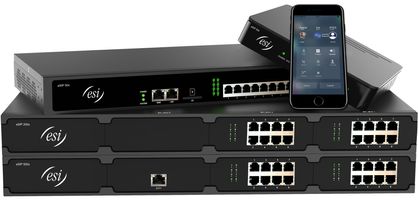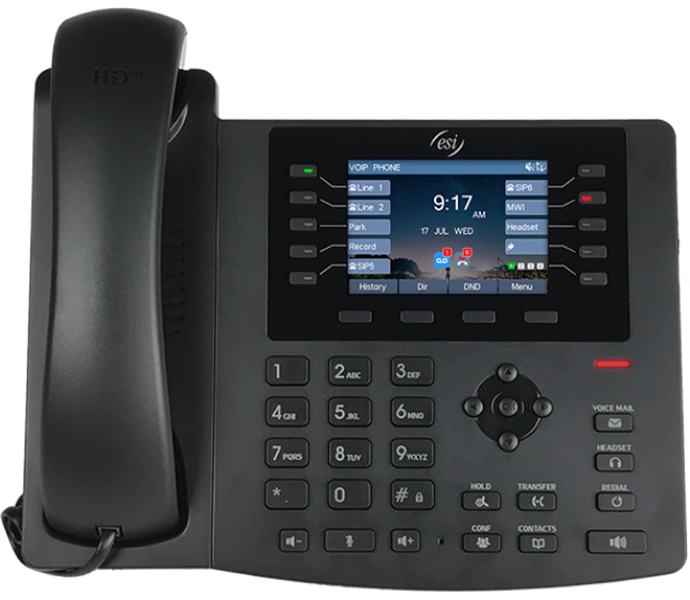- Compatible with eSIP Evolution Series™ and ESI eCloud PBX™
- 6 SIP Accounts
- HD Voice (handset + speakerphone)
- PoE Enabled - Optional external power supply sold separately
- 3.5 inch color LCD Display
- Handset / Hands-free / Headset modes
- Electronic Hook Switch - support for Plantronics® headsets
- Intelligent Programmable Feature Keys
- Desktop / Wall-mount installation
- Industrial Standard Certifications: FCC
Features and Specs
Overview
Call Features
- Call out / answer / reject
- Mute Key
- Call Hold / Resume
- Call Waiting
- Intercom
- Caller ID Display
- Speed Dial
- Call Forwarding (Always / Busy / No Answer)
- Call Transfer (Blind / Supervised)
- Call Parking / Pick-up (depending on server)
- Redial/Auto-Redial
- Do-Not-Disturb (per account)
- Auto-Answering (per line)
- Voice Mail
- Local 3-way Conference
- Hot Line (off-hook dial)
Phone Features
- Phonebook (500 entries)
- Remote Phonebook (XML / LDAP)
- Call log (100 entries, in / out / missed)
- Black/White List Call Filtering
- Voice Message Waiting Indication (VMWI)
- Programmable Feature Keys / Soft keys
- Network Time Synchronization
- Action URL / Active URI
Audio
- HD Voice Microphone/Speaker (Handset/Hands-free, 0 ~ 7KHz Frequency Response)
- Wideband ADC/DAC 16KHz Sampling
- Narrowband CODEC: G.711a/u, G.723.1, G.726-32K, G.729AB
- Wideband CODEC: G.722
- Full-duplex Acoustic Echo Canceller (AEC) - Hands-free Mode, 96ms tail-length
- Voice Activity Detection (VAD) / Comfort Noise Generation (CNG) / Background Noise Estimation (BNE) / Noise Reduction (NR)
- Packet Loss Concealment (PLC)
- Dynamic Adaptive Jitter Buffer up to 300ms
- DTMF: In-band, Out-of-Band - DTMF-Relay (RFC2833) / SIP INFO
Networking
- 10/100/1000 Mbps Ethernet, dual bridged port for PC bypass
- IP Configuration: Static / DHCP / PPPoE
- Network Access Control: 802.1x
- VPN: L2TP (Basic Unencrypted) / OpenVPN
- VLAN
- QoS
Protocols
- SIP 2.0 over UDP / TCP / TLS
- RTP / RTCP / SRTP
- STUN
- DHCP
- PPPoE
- 802.1x
- L2TP (Basic Unencrypted)
- OpenVPN
- SNTP
- FTP / TFTP
- HTTP / HTTPS
- TR069
RFCs
- 354 / 1321 / 1350 / 1769 / 1889 / 1890 / 2131 / 2132 / 2616 / 2617 / 2661 / 2833 / 2976 / 3261 / 3262 / 3263 / 3264 / 3265 / 3268 / 3311 / 3489 / 3711 / 4346 / 4566 / 5630 / 5865
Deployment & Maintenance
- eSIPx Bulk Auto-Provisioning
- Auto-Provisioning via FTP / TFTP / HTTP / HTTPS / DHCP OPT66 / SIP PNP / TR069
- Web Management Portal
- Web-based Packet-dump
- Configuration Export / Import
- Phonebook Import/Export
- Firmware Upgrade
- syslog
Physical Specifications
- LCD: 3.5 inch (320x480) color-screen
- Keypad: 42 keys, including:
- 10 Programmable Feature Keys with tri-color LEDs
- 4 Soft-keys
- 7 Function keys (Hold, Call forward, Conference, MWI, Handset, Phonebook, Redial)
- 4 Navigation keys + 1 OK key
- 12 Standard Phone Digits keys
- 3 Volume Control keys, Up / Down / Mute (Microphone)
- 1 Hands-free key
- HD Hands-free Speaker (0~7KHz) x1
- HD Hands-free Microphone (0~7KHz) x1
- HD Handset (RJ9) x1
- Standard RJ9 Handset Wire x1
- 1.5M CAT5 Ethernet Cable x1
- RJ9 Phone Jacket x2: Handset x1, Headphone x1
- RJ11 port x1: Extension Module x1
- RJ45 Ethernet Jacket x2:
- Network x1 (802.3AF POE Class 2 Enabled)
- PC x1 (Bridged to Network)
- Main Chipset: Broadcom
- DC Power Input: 5V / 1A
- Power Consumption:
- Idle - 1.3W ~ 2W, Peak - 3W ~ 4.7W
- Working Temperature: 32 ~ 104° F
- Working Humidity: 10 ~ 65%
- Dual-Functional Back Rack x1: Desktop Stand / Wall- mount
- Color: Black
- Device Dimensions: 9.5 x 8.5 x 7 inches (Desktop Stand)
ESI ePhone 4x User Guide
Getting Started
Placing an External Call
- Lift the handset or press Speaker key or Headset key.
- Enter the phone number and press # or Dial soft key to dial immediately, or wait for the phone to send the number automatically.
- To end the call, press End or either replace the handset or press Speaker key or Headset key.
Answering a call
- Lift the handset, or press Speaker key or Headset key. Pressing the Answer soft key will connect you to the call through the speaker.
- Pressing the Headset key will connect your call through the headset.
- If auto-answer is enabled, you’ll automatically connect to the inbound call through the speaker.
Adjust Phone Preferences
Press Menu soft key then scroll to and select 3 Settings > 1 Basic Settings . From there, you can program Display, Energy saving, Sleep Time, Ring Settings, Voice Volume and more.
Hold
While on an active call, press Hold key or Hold soft key. To return to the held call, press the Hold key, the line DSS key, or the Resume soft key.
Connecting to a second inbound call
If you receive a second call while you’re on an active call, the display will split and you will hear a beep, indicating a new call:
- Press line 2 button
- Bottom left soft key/button changes
- Select Answer
To return to previous call:
- Press Line 1
- Bottom left soft key/button changes
- Select Resume
Call transfer
- While on an active call, press Transfer key or XFER soft key.
- Dial the number to which you want to transfer the call (or press a programmable feature/DSS key to which that number has been assigned).
-
To make a
blind
transfer, press #, Dial, Transfer key or XFER soft key and hang up or press End soft key.
To make a supervised transfer, wait for the call to be answered by the transfer-to-destination. After confirming that the person will accept the call, simply press Transfer key or XFER soft key and hang up to complete the transfer.
Key System Features
Some keys mentioned herein may need to be assigned to a programmable feature/DSS key. For more details, consult your System Administrator.
Three-way Conference
- Call the first participant of the conference call and when he/she answers, press Conference key or Conf soft key, 1st caller is put on hold.
- Call the second participant and, when he/she answers, press Conference key or Conf soft key. This will join all three participants (counting you).
- To end the three-way conference call, hang up or press End soft key.
Call Forwarding
- Press Menu > 2 Features > 1 Call Forward.
- Select the line, the type of Forward, toggle to Enabled (using navigation keys), enter the destination number and Save. Once enabled, the Call Forward activated icon will appear on the display (top right corner).
- To disable call forwarding, select Menu soft key > 2 Features > 1 Call Forward. Then select Disabled and save.
Note: Unconditional forward is synonymous to Call Forward Always.
Call Park
Call Park places a call in a holding state but can be picked up by any phone on the system.
- Press Park DSS key to park the call. An announcement will state where the call is located (i.e. 10, 11).
- To retrieve the parked call, dial the park number followed by # (i.e. 10#, 11#).
Mute & Do Not Disturb (DND)
Mute - While on a call, press Mute key to disable outbound audio via the microphone in your phone’s speaker, handset, or (optional) headset. The screen will display the Mute activated icon and say Mute to indicate that muting is enabled. To disable, press Mute key again. (Mute will automatically disable when you hang up the call.)
DND - When the phone is idle, you can put the phone in DND (do-not-disturb) mode by following these steps:
- Press DND soft key, or go to Menu > 2 Features > 5 DND.
- Select the Mode and Type, and press Save soft key.
This sends incoming calls directly to voice mail. The DND activated icon will appear on-screen to indicate that DND is enabled. To disable, repeat the above steps.
Voice Mail (VM)
- To access your voice mail messages, press the Voice mail key, or Menu > Applications > 3 Voice Messages.
- Select the line and press Dial soft key to call.
- At the prompt, enter your password, then press #. The system will tell you how many messages you have. (This is displayed on your LCD screen - i.e. MWI: 2).
Call Queue
A call queue is created during system programming. While on an active call, press Transfer key or XFER soft key, then Call Queue DSS key to place the call in queue. To retrieve the calls from the queue login to the queue using the Agent Login/out key.
Agent Login/Logout
This feature allows an agent to log into and out of an automatic call distribution (ACD) queue to manage incoming calls.
- To log in, press pre-programmed DSS key.
- To log out, press pre-programmed DSS key again.
Call History
This presents a list of the last 100 dialed, answered, and missed calls to/from your extension.
- Press History soft key, Up navigation key or Menu soft key > 6 Call Logs > 1 Local Call Logs.
- Scroll to (using navigation keys) and select the desired call by pressing the OK key.
- Press either Dial soft key to dial the number or Option soft key > 4 Delete > Yes soft key to remove the call record.
Recording
This feature allows you to record a call. All users have access to this feature. Recordings are located with your system administrator.
- While on an active call, press the Record DSS key.
- To end the recording, press the Record DSS key or hang up.
Note: A Record DSS key needs to be programmed.
Status Indicator
The programmable feature/DSS keys flash to indicate that you have either a new incoming call or a new voice mail message. The DSS key will stay lit (red) during an active call. The DSS key will flash (yellow) when a call is on hold.
Redial
- Press Redial key.
- Scroll to desired call.
- Press Dial soft key, pick up handset, press Headset key, or Speaker key.
Phonebook
Access Phonebook:
- Press Phonebook key or Dir soft key.
- Select Contacts (Press 1 on keypad, Enter soft key, or OK navigation key).
- To dial an entry, press Dial soft key or pickup handset or press Headset or Speaker.
Add new entry:
- Press Phonebook key or Dir soft key > 1 Contacts > press Add.
- Enter name and number, then press Save soft key.
Intercom
To send a quick announcement to someone without ringing his/her phone, press Intercom feature/DSS key and enter the extension you want to call. If the other user’s phone is idle, it will auto-answer via the speakerphone. Intercom applies to internal calls made from ESI SIP phones.
Personalizing your ePhone
Programming Feature/DSS keys from the Phone
- Press Menu soft key.
- Scroll to to and select 3 Settings > 1 Basic Settings > 1 Keyboard > 1 DSS Key Settings.
- Scroll to and choose (Enter soft key or OK) the desired DSS key (1-36).
-
Scroll to and choose the desired key
Type
( Memory , Line, Key Event,DTMF, URL, BLF List Key, Multicast, or Action URL) and enter the associated information. - Press Save or OK.
Tip: Programmable keys start with key number 1 at the top-left corner on page 1; top to bottom, left to right, ending with key 36 on page 4.
Programming a Speed Dial key
A speed dial key can be programmed for phone numbers or extensions that you dial most often.
- Press Menu. Go to Settings > Basic Settings > Keyboard > DSS Key Settings.
- Scroll to and select (OK navigation key or Edit soft key) the desired key to program.
- Set type as Memory Key and subtype as Speed Dial. Enter name and number and press Save.
Programming Feature/DSS keys from the Console
For eSIP systems, use the Communicator Console. For eCloud systems, use the eConsole dashboard.
Voice Mailbox Options
Here you can change your greetings, record your name and you can change the password for your voicemail.
- Access your voice mailbox, press the Voice mail key.
- Enter your password and press #. The system will then tell you the number of messages you have.
Note: Check the back of your phone to determine if you are on
eSIP or eCloud.
If serial number is
5000-0911, you’re on an eSIP system. If 5000-0921, you’re
on an eCloud system.
Compatible Systems

ESI eSIP Evolution Series
The all-new ESI eSIP Evolution Series delivers power, performance, flexibility and scalability for small to mid-sized enterprises up to 500 users.

ESI eCloud PBX
The ESI eCloud PBX delivers a smarter approach to business communications, making it easy to communicate anywhere, anytime, from any device.

























